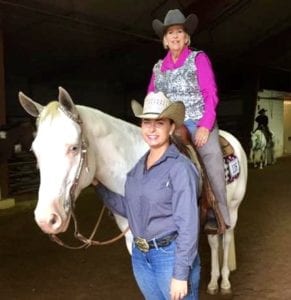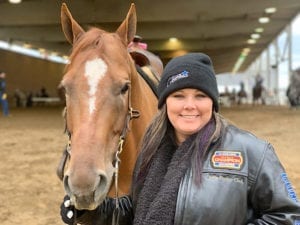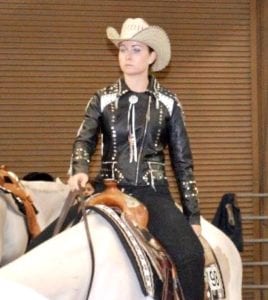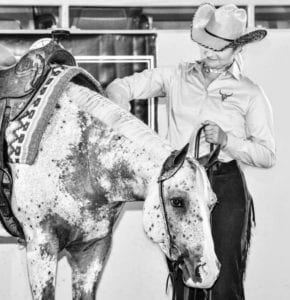As the ever-changing equine industry continues to grow and transform, so do the trainers. There has been a noticeable trend of trainers hiring temporary training assistants for significant horse shows. These people have been able to make a living on just working for different trainers at big shows.
Their responsibilities can range from feeding and cleaning stalls to longing, riding, and showing. The flexibility of the schedule, the experience, the connections gained, and the opportunity to work with the best trainers in the industry, help draw people to this growing segment of the horse show work force.
In this article, we take a look at what it’s like to be part-time horse show help and the pros and cons for both the short-term assistants and trainers who hire them.
Meet some part-time helpers
 Kara Quarles of On Q Horse Show Help has been involved with horses for as long as she can remember. Quarles was involved in 4-H horse judging and showing throughout her youth career, and in 2014, she got a job working for a local trainer.
Kara Quarles of On Q Horse Show Help has been involved with horses for as long as she can remember. Quarles was involved in 4-H horse judging and showing throughout her youth career, and in 2014, she got a job working for a local trainer.
 Georgia native Kerrington Wagner has been riding her whole life. Wagner is mostly self-taught, gaining much of her knowledge from watching other trainers and riders and testing out their methods on her horses at home. Wagner typically has about four to eight Pony of America (POA) horses in training when she’s not at shows.
Georgia native Kerrington Wagner has been riding her whole life. Wagner is mostly self-taught, gaining much of her knowledge from watching other trainers and riders and testing out their methods on her horses at home. Wagner typically has about four to eight Pony of America (POA) horses in training when she’s not at shows.
 Caitlyn Scofield grew up with halter and western pleasure horses. Her passion for the horse grew as she started showing in 4-H and AQHA events. Scofield has always trained her horses at her Minnesota home.
Caitlyn Scofield grew up with halter and western pleasure horses. Her passion for the horse grew as she started showing in 4-H and AQHA events. Scofield has always trained her horses at her Minnesota home.
Benefits of hiring horse show help
 Ashley Dunbar-Clock, of Highpoint Performance Horses, says, “There’s so much to be done at these major shows.” Saltwater appointments, walker sessions, treatments, longing, and more. “It’s so nice to have an extra set of hands for all of this. It’s less stressful not to have to juggle all of those things and still go out there and show at your a-game. Having the extra help, even to shuttle horses around at these big complexes with many arenas, makes a big difference when we have to work with so many horses. With the temporary trainers, I feel more prepared to show at my full potential.”
Ashley Dunbar-Clock, of Highpoint Performance Horses, says, “There’s so much to be done at these major shows.” Saltwater appointments, walker sessions, treatments, longing, and more. “It’s so nice to have an extra set of hands for all of this. It’s less stressful not to have to juggle all of those things and still go out there and show at your a-game. Having the extra help, even to shuttle horses around at these big complexes with many arenas, makes a big difference when we have to work with so many horses. With the temporary trainers, I feel more prepared to show at my full potential.”
 Kara views some of the benefits for trainers hiring temporary help as “It allows the trainers to hire full-time help. It gives the helpers a “tryout” to see how they work and if they get along with the other hands.”
Kara views some of the benefits for trainers hiring temporary help as “It allows the trainers to hire full-time help. It gives the helpers a “tryout” to see how they work and if they get along with the other hands.”
Scofield sees some pros to hiring help at shows as “It’s nice for trainers because they can fly someone in for a show versus having to bring multiple people. I also think it’s easier for trainers to find temporary help rather than a full-time worker.”
Caitlyn says the best part of training at shows for her is the flexibility. She explains, “I’m still in school, so it’s great for me because I get to do what I love and still get an education.”
Potential downsides
Although hiring temporary trainers usually runs smoothly, some issues can arise during the use of temporary help. If it’s a new helper, you don’t know how they will perform or if they will be able to get the job done. The temporary barn hands might not get along with existing help or with the clients. It can also sometimes be a struggle for the new help to make substantial, working connections with the horses.
 Scofield mentioned how getting to know the trainer’s clients and horses can be a challenge at first. “It takes a few days, but once you get the hang of how the trainer operates and what the horses are like, it usually goes pretty smoothly.”
Scofield mentioned how getting to know the trainer’s clients and horses can be a challenge at first. “It takes a few days, but once you get the hang of how the trainer operates and what the horses are like, it usually goes pretty smoothly.”
Caitlyn mostly works with Vickery Performance Horses out of Sanger, Texas, so there is a routine that comes into play. Kerrington says it’s easy when it comes to working with new trainers for her. “I’m an extrovert, so it’s easy for me just to go have a conversation with anyone, and I love talking to people, especially horse people,” she says. However, this might not be as easy for other temporary help.
Want to start training at shows?
 Long, exhausting, twelve to fifteen-hour days, fun, though hard work, and a pay rate ranging upwards of $100 a day are all a part of the job of being a horse show helper. Pay may vary based on the trainer, show, or work expectation. Agreements on pay between the horse show helper and trainer are made before the show. Some contracts include a flat rate fee, while others cover travel, food, and board.
Long, exhausting, twelve to fifteen-hour days, fun, though hard work, and a pay rate ranging upwards of $100 a day are all a part of the job of being a horse show helper. Pay may vary based on the trainer, show, or work expectation. Agreements on pay between the horse show helper and trainer are made before the show. Some contracts include a flat rate fee, while others cover travel, food, and board.
Getting to travel all over the country, working for some of the top trainers in the industry, and being her own boss are some of Kara’s favorite things about the job. Quarles’ advice for people thinking about training at shows is, “Don’t be afraid to ask people. If you want to stay in the industry, but don’t necessarily want to be a full-time trainer, this is a great opportunity. Just get out there and get exposure.” Kara got into training at shows to help a friend at first, and she started training at shows full time in 2018.
Though many people might not know about these temporary training opportunities, training at shows can be a great way to do what you love, stay in touch with horse show friends, and still be able to bring home a paycheck. Though the pay ranges are based on who you train for, many people have been able to make their living on temporary training alone.
Whether you have training experience or are just a regular horse show goer, it will never hurt to ask to help someone and their operation, even if it’s just feeding horses or sweeping barn aisles. Experiences like these can help you dig up an unforeseen passion for training horses at shows.









